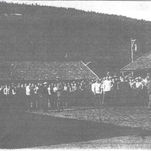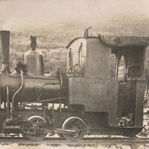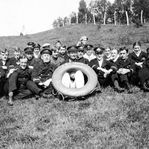Jørstadmoen
I have used sections of my book to provide a brief rundown of life in the camp for the 39 months the HMS India crew were interned. More information is available in the book – can’t be giving everything away!
After joining the men who had rowed themselves to safety, most of the 108 interned British sailors and officers were taken south to a town near Lillehammer. It involved putting the assumedly traumatized men back on to a boat and sailing them to where they could catch a train to Jørstadmoen where they were placed in an army camp that would become their home for the next 3 years and 3 months. A small village, the people of Jørstadmoen must have been intrigued by the addition of so many men to their village. The army base was quickly altered to contain the men with tall, barbed wire fences being erected and armed guards being put on duty. Initially there were one hundred men guarding but once the barbed wire fences were constructed in September 1915 the number of guards was reduced to around sixty men. Photos of the early days show tents set up as well as the barracks which were arranged in a U shape. Officers were initially given tents of their own, whilst the men were in the barracks in rooms of around seven men.
Very quickly routines were established and a sense of boredom and homesickness were felt, even at this early stage. There is obviously an intention to keep the men busy and “in line” (somewhat literally) as the men went out on daily marches and there is a photograph of men marching through a township. However, the opportunity to see the local town, in what would become a regular outing, sounds like a good escape from the tedium of the inside of the camp.
Early in 1916, the interned Officers from HMS India were moved out of the camp into alternate accommodation in Suttestad, a nearby village. Eleven officers were moved to Sole Pensjonet which was owned by Mrs Aslaug Haak. This was a temporary arrangement and later they were moved into more permanent accommodation. The officers were allowed to have their servants—a total of six men. The officers also developed for themselves an active social life in and around Lillehammer.
Also, early in 1916, Commander Kennedy got married. He married the daughter of a Norwegian Naval Commander, Alice Fedora Esther Lundh, on 28 February and the crew commemorated the occasion with a silver platter.
The engagement announcement and marriage ceremony were unusually close together with the engagement announced in the Norges Handel og Sjofartstedente paper on the 11 February and the marriage taking place only seventeen days later. A local newspaper announced the nuptials—“celebrated on the 28th by Miss Fedora Lundh, daughter of Commander Harold Lundh and Mrs Thorpe and Commander W.G.A Kennedy R.N, currently interned in Norway. The wedding ceremony will be held in the English Church at 12.”
One of the biggest events in the first half of 1916 involved the escape of two British internees. J.W.B Grigson, Able Seaman and shipwright Charles Clinton managed to escape and make their way back to the United Kingdom. Charles Clinton has been difficult to trace after his escape but after the war had ended, he was recorded as being back at work in the Drawing Office at Denny’s Shipyard in Dumbarton.
John William Boldero Grigson was easier to research and his life continued to be interesting after his escape. Grigson had signed up with the RNVR in 1913 and in 1914 was transferred to the Royal Navy division. He joined the India on the 13 April 1915 and was one of the few who managed to get a place in one of the India’s lifeboats when she was torpedoed.
After escaping on the 19 May it was not long before Grigson was commissioned into the Royal Navy Air Squadron on 20 August. Grigson became a highly decorated Air Commodore who flew in both World War 1 and 2 but in all the writing I have seen on him not one piece mentions that he escaped from a prison camp. Some assume that he got sent home on the Gotaland but the escape is never discussed.
The Grigson/Clinton escape had a knock-on effect for those remaining in the camp. The conditions had become slowly more liberal prior to the escape with an easing on the numbers of armed guards and extra freedoms being allowed to some of the prisoners but this stopped once Grigson and Clinton managed to gain their freedom and make their way home. Arnold mentions “bayonets and loaded revolvers” were prevalent and the mood in the camp changed.
Considering that the ‘gentlemen’s agreement’ between Norway and Britain stated that men on leave would return to the camp, it seems odd that Grigson was able to move into the RNAS and continue serving after his escape.
June of 1916 had brought with it signs of unrest from some members of the interned crew. The escape of Grigson and Clinton had stirred things up in the camp and select internees were voicing their unhappiness about the conditions they had found themselves in. The files at the National Archives reveal more information on exactly how the escape took place.
The British Legation in Norway report that Commander Kennedy had requested that Grigson be allowed to assist him with work “outside the camp” and this was allowed after Kennedy had provided a personal guarantee that Grigson would adhere to the rules of his internment and not try to escape. Grigson was provided with a special mark to wear on his arm to make his easily recognisable.
The report goes on to say, “The Norwegian Authorities concerned now believe that the Mark has been used first by Grigson and then by Clinton, the fact that the whole guard was changed on the very time the escape took place, pending to facilitate their passing out of the camp unnoticed. Most likely Grigson has sent the work to Clinton by letter, immediately after he himself had got out and in fact the mark was found, after the escape had been discovered in a letter addressed to two of the interned by the name of Atwood and Woolford.”
There were also reports that Clinton may have stolen a bicycle which may have assisted them in their escape. The Lillehammer Spectator reported on 14 June 1916, that letters had been received by a local business which contained money for the repair of two ‘borrowed’ bicycles. The letters had Scottish stamps on them.
With the escape of Grigson and Clinton and the subsequent tightening of the restrictions on freedoms added to the grumblings on conditions and the growing awareness that this incarceration was not going to end anytime soon, back in England the message was getting through that the crew was unhappy. The National Archive files contain letters of complaint made to newspapers, government officials and others. The unrest and letters of complaint certainly highlighted the divide between the men and officers and allowed those living out of camp a totally dissimilar experience of interment than those behind the barbed wire fences being watched by armed men. Several officers married and started families and stories and photos exist of parties with local women and drinking and feasting. This was not happening in the camp where the men were left to primarily create their own entertainment.
The second half of 1916 saw the beginning of a programme of work that took some of the men out of the camp and further north to work on the construction of the Dovrebanen railway. Whilst HMS India crew were not permanently on site for the construction works, many spent a considerable amount of time away from the camp working on the railway on and off for the remainder of the war.
The boredom of camp life meant that for some internees the opportunity to escape it all by drinking in local bars or creating a bit of trouble proved too tempting. An article from a local history book, Faberg og Lillehammer—Ek lokalskrift utgitt av Fåberg Historielag, sheds light on the trouble a small number of the English internees could get up to both inside and outside of the camp and early 1917 features a couple of notable incidents.
In January, the station master complained that a small group of the English interns from Jørstadmoen were arrested for disorder and intoxication. Private Albert Hopkins and fireman W Price were sentenced to three days in prison after their big day out. This was followed in March by an incident in the camp. It is described in the article:
“March 17, there was a great spectacle in camp. Some Englishmen who have been in town were full when they returned. The worst were Haars (I think this is supposed to be Fireman S Hawes) and Jack Philip (Private). Jack Philip has returned from Akershus (a prison) a few days before where he had spent 30 days.
When they came into the camp, one of the guards was supposed to take him and have him on the square, but this was probably not to the Englishman’s taste. He flew at the guard and struck him on the head, the guard shot at him with the revolver but did not hit. The Englishmen inside the fence kept storming this, including Felice Spiteri (Fireman) and Edward McKeever (Stoker).
July 1917 started with an official count of all the men in camp – there were 78 men recorded still living in the camp at that stage. I am unsure if this includes the officers who were officially living outside of the camp.
The poor mental health of some of the men was highlighted most by the tragic case of Able Seaman John Thomas Wells. Reports speak of a man going mad in camp and being taken away by motor car.
From the time Wells is taken from the camp we find nothing about him until the sad letter dated 8 November that has been kept in the file at the National Archives.[1]The letter reads:
“Sir,
I have the honour to confirm herewith my telegram of the 20 October 1917 reporting the death of John Thomas Wells, Able Seaman RFR o.n 187363, which sad event took place suddenly at Prestestæter Asylum near Gjovik on 20 October.
Owing to the very awkward communications between Gjovik and Jørstadmoen, he was buried privately at Gjovik on 26 October. Four of his shipmates accompanied by a sergeant of the guard were allowed to attend the funeral.
I enclose a copy of the death certificate and also a list of private effects of the late A B Wells, as to the disposal I await your lordships command.
The address of his wife is:
Mrs Fanny Wells
5 Sherwood Street
Bromley-by-Bow
London.”
The most heart-breaking sentence, for me, in this official letter is “which sad event took place suddenly at Prestestæter Asylum.” It seems clear that John Thomas Wells took his own life in this Norwegian Asylum on his own, away from all he knew and loved. One can only imagine how shocking this must have been for many of the men at Jørstadmoen. They would have been witness to a man going mad, a madness that led to his eventual suicide.
Unrest was the mood that kicked off 1918. The letters sent by Private Albert Hopkins towards the end of 1917 reignited discussions over conditions in the camp and an unfortunate incident very early in the new year set an unsavoury tone to the start of what would be the last year at Jørstadmoen.
A long letter written by Commander Kennedy to the British Legation on the 7 January outlines the “trouble we had in camp here on the 1 January and subsequent days.” He explains that a new rationing list had been sent to camp and he had encouraged the men to “accept it for about 14 days and then I would try and have it amended. On the 1 January the ration for the day was Salt Meat. This the men absolutely refused to touch and said they would go on a hunger strike.”
They were talked down and replacement meat was arranged using temporary supplies from Lillehammer “but when they came to draw the meat, they again refused to take any, this time on the ground that there was a great deal too much bone and, on the 5 January, they refused to muster in the morning and the gates were closed and all privileges stopped.”
He goes on to explain that he then went and met with the officers and inspected the meat “which was by the way nearly all ribs and very little meat.” He then arranged for the old rationing to be restored and considered that things were then back to normal. However, “the men also complained that a guard with fixed bayonets had been marched into camp on the evening of the 4 and patrolled inside the camp. This they resented very much and I think was the reason for refusing to muster in the morning.”
Apparently, the Camp Commander had been informed by telephone that someone “had heard on good authority that the men were going to burn the camp down. I assured the Camp Commandant that I did not think that there was any likelihood of any trouble occurring provided the guard was kept out of the camp.” With all the skiing and swimming and niceties of the camp, I think that, at times, it is easy to forget that Jørstadmoen was a Prisoner of War camp and that the men inside it were being held against their will by armed guards.
On the other hand, socialising, and fraternising with those inside and outside of the camp seemed to have really hit its stride in 1918. There were dances, sing songs and the Varieties Theatre concert. Whilst he is not often in the mood for taking part, many others, especially the officers, seem to relish the opportunity to relax and have a bit of fun.
There are stories and photographs of the Officers really getting into socialising in the towns and villages where they were based. The Norwegian article sent to me by the descendants of Lieutenant Alltree states, For the officers, the class differences were also reflected in the fact that a New Year’s ball was organised with the district’s finer daughters sock guests. Anine Wollebæk Slaatto was among those invited and remembers that she reacted to the strange serving, a kind of sitting buffet and Deborah Callaghan, the granddaughter of Chief Engineer Charles Nelson, tells of a photo album she had inherited with photos of her grandfather partying with other men and women in houses.
The influx of men into a small Norwegian town had an impact. There are stories of Norwegian guards spending time chasing girls away from the fences of the camp where they were trying to sneak kisses from the interned men. A guard from the camp wrote to a local paper, using the name ‘Valdris’ and stated that “The biggest task is to remove the girls from the fence, they are very bothered by the English disease.”[2] I imagine many of the men must have enjoyed this attention as well!
This fraternising may be what led to many of the love affairs, engagements and marriages that occurred between the officers and crew of HMS India and the women of the local area.
Through research I have been able to confirm seven marriages and two engagements not including the marriage of Commander Kennedy in 1916.
[1] Letter can be found at The National Archives file FO 383/327
[2] Rønning, O. (Husemoen, O & Hosar, K). Fra dragon og musketeer til elektronik og data: eServer plassen Jørstadmoen. Lillehammer Thorsud Lokalhistorisk fori. 1998





























